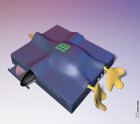Ambient Music, Deconstructed
Introduction
I recently stumbled upon the most awesome musical machines I had ever found. On Stephane Pidgeon's website, I found several "machines" in software that generate ambient musical soundscapes. First, I think the musical quality of these "machines" is incredible! They sound very beautiful and very relaxing.
I contacted Stephane Pidgeon to ask him if he teaches classes on how to create ambient music, out of respect and a desire to support him. He declined teaching me, saying I can just analyze the soundscapes he created for clues on how to create ambient music.
So I am going to try to analyze his soundscapes. By the way, I strongly recommend that you donate to Stephane Pidgeon's website if you find this document, or his soundscapes, useful. In fact, consider buying these soundscapes in recorded audio files.
This page is a work in progress.
Black Hole
I love how this generator sounds! This
soundscape is composed of several parts: engine rumble, distant
explosions, low voice, vocal pad, pad, hum, limbus,
interferences, haunting, and shimmer. I will try to
analyze each part.
- Engine rumble: this is a very low, constant, rumble.
- Distant explosions: this is about the same frequency as the engine rumble, but it is a constant "bloom" effect that comes and goes, with a sharp attack.
- Low voice: this sounds slightly like a voice, and is very
low in frequency. It has a very sinusoidal attack and
decay, with lots of low frequency noise. The vowel
doesn't seem to change much. The range of the note seems
outside of normal human vocals (in how low it is).
- Vocal pad: this is a low frequency (but within the actual human vocal range). It also has a sinusoidal attack and decay, and the vowel doesn't seem to change very much. It also seems to include a synthesizer pad elements, possibly saw waves.
- Pad: this is a high frequency shimmering pad sound that seems almost constant. Its volume seems to be sinusoidal as well. It seems to begin gradually in an almost "ooh" vowel or square wave, but then becomes most of a saw wave. It does not seem to have much bass range (probably lots of high pass filter). It sounds like it is a minor third, in terms of the specific notes, or possibly a minor with a minor 7th chord. It seems to be more resonant in the higher frequencies.
- Hum: this portion seems to change chords. It seems to begin in the higher notes, with almost a vocal-like "ooh" sound from, say, a female choir. It also contains pad and shimmer elements. It seems to begin in a major chord with a major 7th, and then become a minor chord with a minor 7th. It seems to do this by substituting one note for another. I do not know what key it is in, but the chord doesn't seem to change the key signature. It seems to transition from (example: in the key of C/A minor) from A C E G (A minor 7) to F A C E (F major 7) by alternately fading the F and G notes in and out. Note that the G seems to be held longer, possibly because that could make the F chord temporarily an F2 chord (F G A C).
- Limbus: this word means "edge." This element appears to be a half-tonal, half-atonal hum sound with lots of noise. Its volume seems to be sinusoidal. Using the example above, if in the key of C/Am, it seems to be playing the notes C and E, with possibly a D note that comes in and out to provide a slightly useful dissonance. This element also seems to have some shimmer, and some volume modulation.
- Interferences: this element seems to be almost like a recording of rain. In volume, it is sinusoidal, coming in and going out smoothly. However, within the sequence of noise, there seems to be a raspy percussion-like dissonant element, like you would hear in various movies in utopian/desert type sections, almost like a sampled sound of a fly buzzing around, but modulated and louder.
- Haunting: this seems to be a high pitched sequence of bell tones, sort of like a bell pad, but the notes have more attack. So maybe 25% pad, 75% bell sound. Almost like synth bell patches, or even maybe wine glass or glass armonica sounds. There are actual notes being played in a sequence. I think the sequence of notes are all within the current key the soundscape is written in, without accidentals (no sharps or flats).
- Shimmer: this is some very high shimmery sounds, as you probably expected. The notes being used are very high in frequency, and fit in the current soundscape key. They appear to contain some elements of ring modulation, and almost sound like mechanical telephone ringers in some way.



